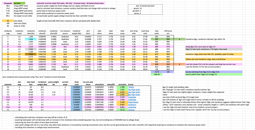back to wire resources
measuring wire resistance
measuring wire resistance:
I've been using "the four wire method" (aka Kelvin's method) to measure the total resistance as well as the
"resistivity" (resistance per foot) of several lengths of moderate to heavy gauge wire I have here. You can't
just use an ohm meter to measure the resistance of 50 feet of #6 wire, it's just going to read zero. But even
if it's only a half an ohm, that can matter. And if it's 100ft of #10 CCA, that's going to create a serious volage
drop / power loss at higher amps. (like 30 amps) Once you know the wire's resistance/ampacity, you can
calculate the loss and make informed decisions as to whether or not you need to upgrade your wire.
The Kelvin method works by passing a known current across the wire (either fixed by the supply, fixed by the
load, or measured with good accuracy), and then using a high precision volt meter to measure the voltage drop
across a segment of the wire. Then just use ohms law to calculate the total resistance. And if you need to
know the wire's ampacity, (resistance per foot, or meter, or mile, or km), you'll need an accurate measurement
of the length of the wire segment as well. Then just scale the resistance based on the segment's length.
the Kelvin method has several advantages:
- you can use a current-limiting supply, current-limiting load, OR decent precision current meter
- it doesn't require expensive precision resistance meters - precision voltmeters are fairly inexpensive
- inserting the test equipment / taking measurements doesn't interfere with the accuracy of the measurement
- it maintains a very high precision even when measuring very small (milli-ohm) resistances

bot off by a factor of 10.txt

Four-terminal sensing (at Wikipedia)
resistance testing (in wire)
resistivity xls:

wire resistance test measurements:

highest resolution images
last updated 05/20/2025 at 19:21:31 by make_www_index.command version 2025.05.20.B



